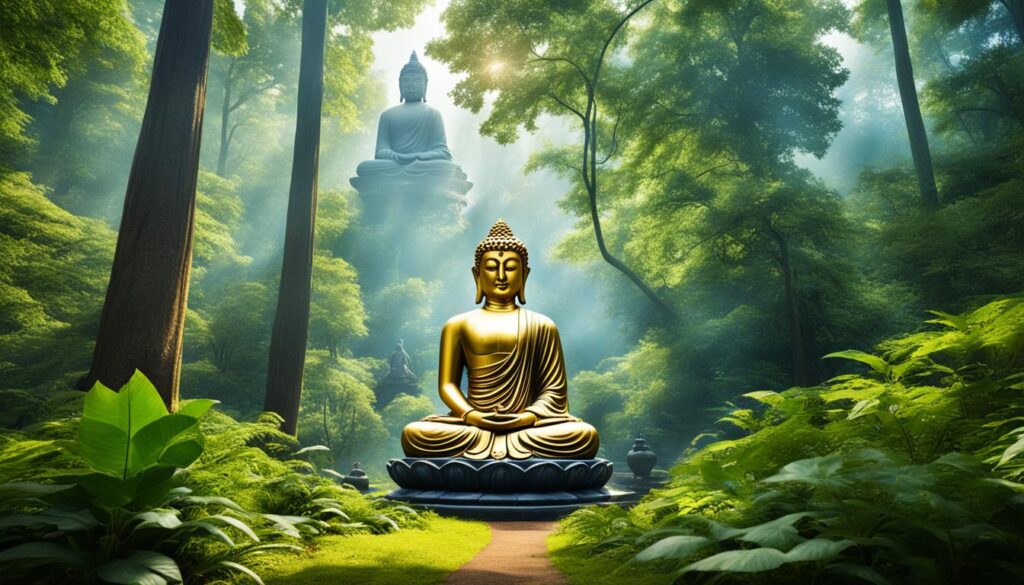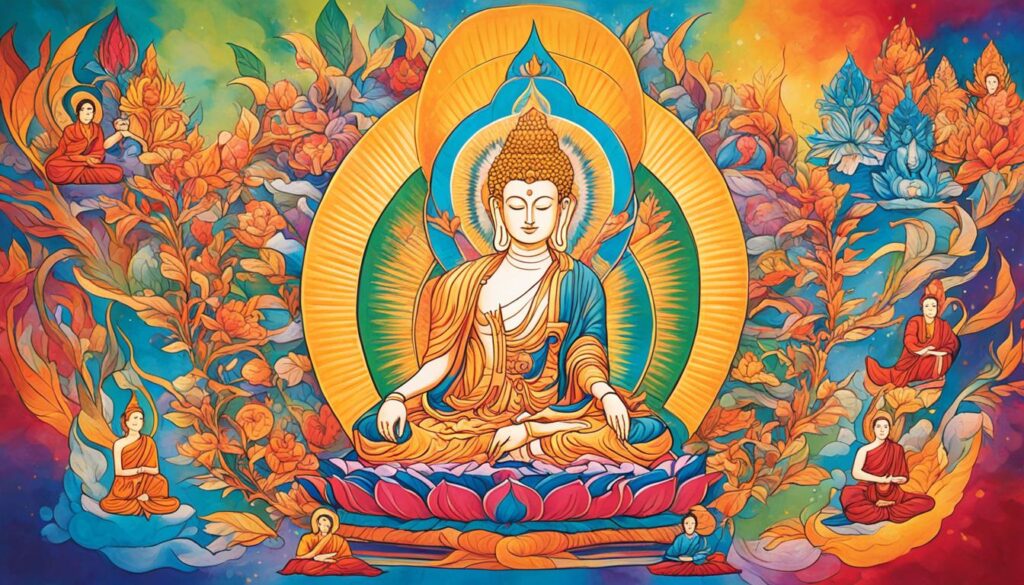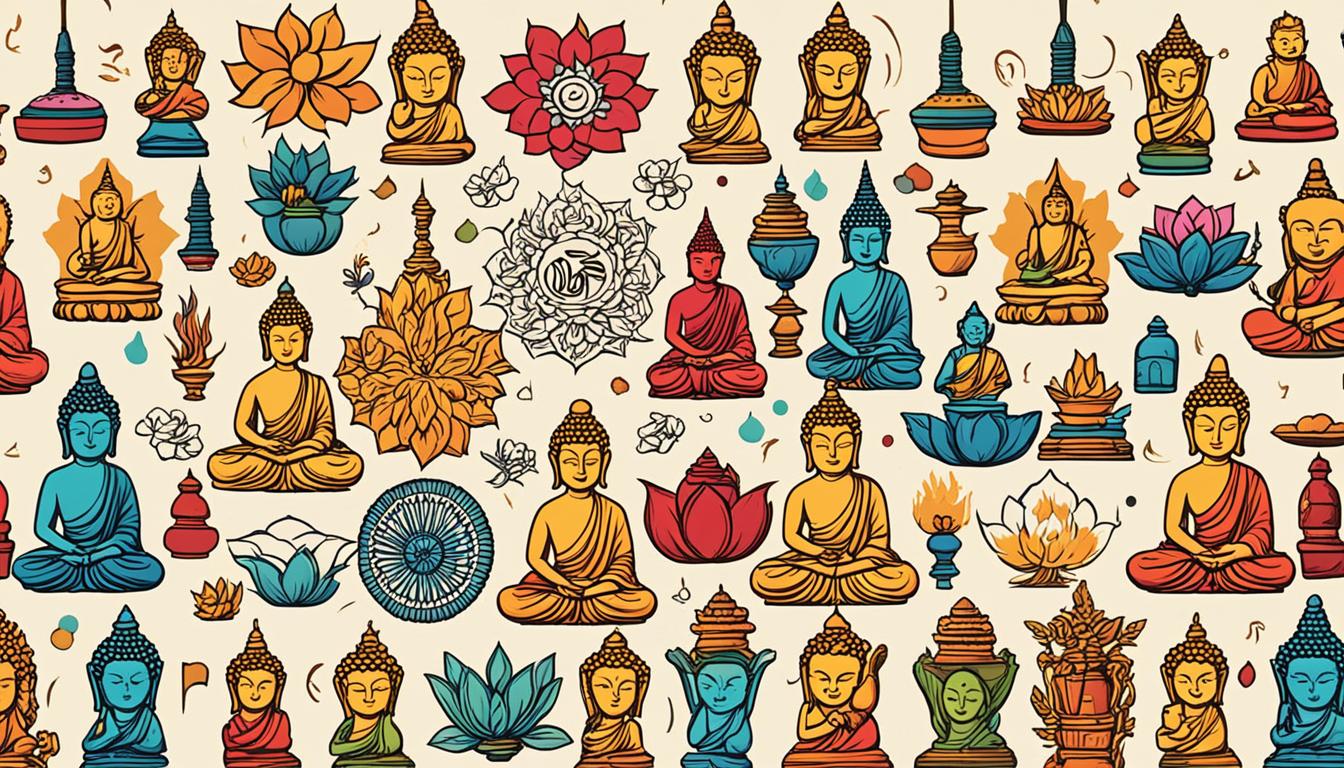“Thousands of candles can be lit from a single candle, and the life of the candle will not be shortened. Happiness never decreases by being shared.” – Buddha
Buddhism is a remarkable religion that encompasses diverse traditions and branches, offering a multitude of paths towards enlightenment. With its origins rooted in ancient India, Buddhism has expanded across the globe, adapting to different cultures and giving rise to various types of Buddhism. These different branches of Buddhism each possess their own teachings, practices, and rituals, providing individuals with a wealth of options for spiritual growth and self-discovery.
Whether you are familiar with Buddhism or are new to exploring its teachings, this article aims to shed light on the vast array of Buddhism traditions and sects. By delving into the distinct characteristics and philosophies of each branch, you can gain a deeper understanding of the intricate tapestry of Buddhism and find a path that resonates with you.
Key Takeaways:
- There are various branches of Buddhism, each with its own unique practices and beliefs.
- Theravada, Mahayana, and Vajrayana are the three main schools of Buddhism.
- Theravada Buddhism emphasizes meditation and following the Noble Eightfold Path.
- Mahayana Buddhism focuses on the bodhisattva ideal and compassion for all beings.
- Vajrayana incorporates tantric practices and rituals into its spiritual path.
The Schools of Buddhism
Buddhism encompasses various schools and traditions, each with its own unique teachings and practices. Understanding the different schools of Buddhism can provide insights into the rich diversity of this ancient religion. Let’s explore the three main schools of Buddhism: Theravada, Mahayana, and Vajrayana.
Theravada Buddhism
Theravada Buddhism, also known as the “Way of the Elders,” is the oldest existing form of Buddhism. This school is predominantly followed in Southeast Asian countries such as Thailand, Burma, Cambodia, and Laos. Theravada places great emphasis on the teachings of the Pali canon, which contains the scriptures believed to be the earliest recorded words of the Buddha.
- Teachings focus on meditation, mindfulness, and ethical conduct.
- Practitioners strive to achieve enlightenment by following the Noble Eightfold Path.
- Theravadins believe in the importance of personal effort and individual liberation.
- Distinct traditions within Theravada include the Thai Forest Tradition, Burmese Buddhism, and Buddhism in Sri Lanka.
Mahayana Buddhism
Mahayana, meaning “Great Vehicle,” is the largest school of Buddhism and is widely practiced in countries like China, Japan, and Korea. Mahayana emphasizes compassion and the bodhisattva ideal, which involves seeking enlightenment not only for oneself but also for the benefit of all sentient beings.
- Meditation plays a crucial role, with various techniques like Chan and Zen emphasizing direct experience of enlightenment.
- Nichiren Buddhism focuses on the chanting of the Lotus Sutra as a means of attaining enlightenment.
- Pure Land Buddhism centers around devotion to Amitabha Buddha and the aspiration to be reborn in the Pure Land.
Vajrayana Buddhism
Vajrayana, known as the “Diamond Vehicle,” is often considered a branch of Mahayana and is primarily practiced in regions like Tibet, Nepal, and Bhutan. This school incorporates tantric practices and rituals to accelerate the path to enlightenment.
- Key features include the use of mantras, visualizations, and sacred rituals.
- Vajrayana places an emphasis on the guru-disciple relationship and the transmission of esoteric teachings.
- Tantric practices aim to harness and transform ordinary experiences into opportunities for spiritual awakening.
Each school of Buddhism offers a unique perspective and path to spiritual awakening. The diversity of Buddhist traditions showcases the adaptability and resonance of the teachings with different cultures and individuals. By deepening our understanding of these schools, we can gain profound insights into the wisdom and compassion that Buddhism continues to offer.
Comparison of Buddhist Schools
| School | Main Geographical Area | Focus | Key Practices |
|---|---|---|---|
| Theravada | Southeast Asia | Individual Enlightenment | Meditation, Mindfulness, Noble Eightfold Path |
| Mahayana | East Asia | Compassion, Bodhisattva Ideal | Meditation, Chan/Zen, Nichiren, Pure Land |
| Vajrayana | Tibet, Nepal, Bhutan | Tantric Practices, Esoteric Teachings | Mantras, Visualizations, Sacred Rituals |

Theravada Buddhism
Theravada Buddhism, also known as the “Way of the Elders,” is the oldest form of Buddhism, originating from the teachings of the historical Buddha, Siddhartha Gautama. It is primarily followed in Southeast Asian countries such as Thailand, Burma, Cambodia, and Laos.
Theravada Buddhists rely on the ancient Pali canon, known as the Tipitaka, which contains the teachings and discourses of the Buddha. The Tipitaka, meaning “Three Baskets,” consists of three sections: the Vinaya Pitaka (rules for monastic discipline), the Sutta Pitaka (discourses of the Buddha), and the Abhidhamma Pitaka (philosophical analysis).
Theravada Buddhists place great importance on meditation as a means of cultivating wisdom and achieving enlightenment. Insight meditation, also known as vipassana, is a key practice within Theravada Buddhism. Through mindfulness and introspection, practitioners develop a deep understanding of their own mind and the nature of existence, ultimately leading to liberation from suffering.
Within Theravada Buddhism, there are various traditions that have emerged over time, each with its unique characteristics and practices. The Thai Forest Tradition is known for its emphasis on solitude and meditation in natural settings. Burmese Buddhism, with its strong monastic lineage, places great emphasis on the study of scriptures and the practice of mindfulness. Buddhism in Sri Lanka, also influenced by Theravada teachings, has a rich history and vibrant monastic community.

| Tradition | Key Features |
|---|---|
| Thai Forest Tradition | Emphasis on solitude and meditation in natural settings. |
| Burmese Buddhism | Strong monastic lineage, focus on studying scriptures and practicing mindfulness. |
| Buddhism in Sri Lanka | Rich history, vibrant monastic community. |
Mahayana Buddhism
Mahayana Buddhism is the largest and most widely practiced school of Buddhism, with a significant presence in countries such as China, Japan, and Korea. Unlike Theravada Buddhism, which focuses on individual enlightenment, Mahayana emphasizes the bodhisattva path and the aspiration to attain enlightenment for the benefit of all sentient beings.
Within Mahayana, there are several distinct traditions that offer unique approaches to achieving enlightenment. Two prominent traditions are Chan and Zen, which originated in China and Japan, respectively. Chan and Zen Buddhism emphasize meditation as a means to directly experience enlightenment in the present moment.
Another significant tradition within Mahayana is Nichiren Buddhism, which traces its roots back to the 13th century teachings of the Japanese monk, Nichiren. Nichiren Buddhists believe in the power of reciting and chanting the Lotus Sutra, one of the essential texts of Mahayana Buddhism. Through the practice of chanting, they seek to attain enlightenment and awaken their inherent Buddhahood.
Pure Land Buddhism, also known as Amidism, is another prevalent tradition within Mahayana. Pure Land emphasizes devotion to Amitabha Buddha and the aspiration to be reborn in the Pure Land, a realm where enlightenment is easily attainable. Pure Land Buddhists chant the name of Amitabha Buddha as a form of meditation and cultivate faith and gratitude towards the Buddha’s infinite compassion.

Through its various traditions and practices, Mahayana Buddhism offers practitioners diverse paths to enlightenment. Whether through meditation, chanting, or devotion, Mahayana fosters compassion, wisdom, and the ultimate goal of liberating all beings from suffering.
| Mahayana Traditions | Description |
|---|---|
| Chan and Zen | Emphasize meditation and direct experience of enlightenment in the present moment. |
| Nichiren Buddhism | Focuses on the chanting of the Lotus Sutra as a means of attaining enlightenment. |
| Pure Land Buddhism | Centers around devotion to Amitabha Buddha and the aspiration to be reborn in the Pure Land. |
Conclusion
Buddhism is a rich and diverse religion, offering a multitude of paths to spiritual awakening. From Theravada to Mahayana and Vajrayana, each branch of Buddhism has its distinct practices and beliefs.
Exploring the different types of Buddhism can provide profound insights into the various ways to achieve enlightenment. Whether you resonate with the disciplined meditation and teachings of Theravada, the compassionate bodhisattva path of Mahayana, or the transformative tantric practices of Vajrayana, each tradition offers a unique approach to finding inner peace and liberation from suffering.
By delving into the teachings and practices of these various branches, you not only deepen your understanding of Buddhism but also cultivate personal growth and contribute to societal harmony. The principles of compassion, mindfulness, and non-attachment are common threads that weave through all types of Buddhism, guiding individuals towards a state of peace, wisdom, and interconnectedness with all beings.
Whether you choose to explore one particular type of Buddhism or adopt an ecumenical approach that embraces the diversity of teachings and practices, the ultimate goal remains the same: the attainment of enlightenment and the cessation of suffering. Through the exploration of different types of Buddhism, you can embark on a transformative journey towards self-realization and a more awakened way of living.
FAQ
What are the different types of Buddhism?
Buddhism can be broadly categorized into three main schools: Theravada, Mahayana, and Vajrayana.
What is Theravada Buddhism?
Theravada Buddhism, also known as the “Way of the Elders,” is the oldest existing form of Buddhism, primarily followed in Southeast Asian countries.
What are some traditions within Theravada Buddhism?
Within Theravada, there are various traditions such as the Thai Forest Tradition, Burmese Buddhism, and Buddhism in Sri Lanka.
What is Mahayana Buddhism?
Mahayana Buddhism is the largest school of Buddhism, popular in many Asian countries including China, Japan, and Korea.
Are there specific traditions within Mahayana Buddhism?
Yes, some traditions within Mahayana include Chan and Zen, Nichiren Buddhism, and Pure Land Buddhism.
What is Vajrayana Buddhism?
Vajrayana, often considered a branch of Mahayana, is practiced in Tibet, Nepal, and Bhutan. It incorporates tantric practices and rituals.
What is the ultimate goal of Buddhism?
The ultimate goal of Buddhism is the liberation from suffering and the attainment of enlightenment.
Are there differences in the teachings and practices of the different types of Buddhism?
Yes, each branch of Buddhism has its own distinct practices and beliefs, while still sharing common teachings and principles.
How does one choose which type of Buddhism to follow?
Choosing a type of Buddhism is a personal decision. It is recommended to explore the different traditions, teachings, and practices to find the path that resonates with you.
Can one practice multiple types of Buddhism?
Yes, it is possible to practice multiple types of Buddhism or incorporate teachings and practices from different schools into one’s spiritual journey.

